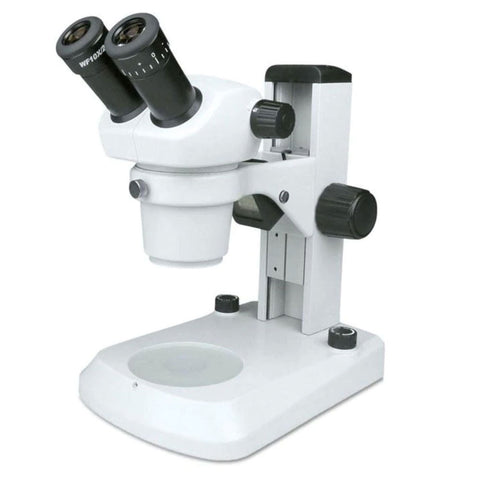
Six different types of microscopes explained
When you hear ‘microscope’, what kind of microscope do you think about? The traditional model once used in schools – waiting your turn, viewing things one by one and with one eye at a time? Or a microscope that allows for more modern technologies like digital imaging and file-sharing?
Today, there’s a wide variety of microscopes in the world, each with their own uses. Below is an overview of 6 basic types of microscopes you’re likely to encounter.
Stereo
A stereo microscope, also known as a dissecting microscope, lets you view bigger 3D specimens, such as insects, rocks or plant life.
They have two eyepieces with separate optical pathways and lower magnification (~60x). And they use visible light to produce a 3D image of your sample. Unlike with some other types of microscopes, the image stays the right way up, so you can freely handle your samples while you look at them.

Optico ASZ200 Stereo Microscope
Stereo microscopes can work with either transmitted light (passes through a sample) or reflected light (bounces off a sample), so they are particularly useful for looking at opaque specimens.
Used in a wide variety of scientific fields and industries, such as the biological and geological sciences, electronics and technical engineering.
Compound
A compound microscope, also known as a biological microscope, uses two sets of lenses to produce much higher magnifications (~1000x). You might be familiar with this type from high school.
They’re generally used to look at extremely small transparent specimens (microorganisms, cells and tissue).

They typically come with multiple objective lenses of different magnifications that can be rotated into place to provide both an overview and a detailed look at your samples.
Used in the biological sciences, as well as medical and veterinary professions.
Inverted
Inverted microscopes function similarly to traditional microscopes but (as the name implies) the layout of the objective lenses and the lights are reversed. The light source is located above the sample while the lenses are below it. There are two main varieties.
Biological inverted microscopes
These generally have a range of magnifications up to 400x and are used to view living samples in petri dishes or larger containers.
The samples are viewed from below for a number of reasons:
- Cells in solution naturally fall to the bottom of a container where they stay in the same focal plane.
- Cells have access to more of the fluid medium than when jammed between a slide and a coverslip.
- There is no risk of contaminating the lenses through accidental contact.
- They allow the sample to be accessed while examination is underway.
Used in a wide range of biological sciences, from neuroscience to microbiology.

Optico ANIB-100-LED Inverted Biological Microscope
Metallurgical inverted microscopes
This type is used to inspect opaque objects that are too large for a regular microscope. They have similar magnifications to their biological equivalent but are used to inspect metals and minerals instead of organic material.
Used in manufacturing and engineering to inspect metals for faults, stress damage and fatigue.
Metallurgical
Upright metallurgical microscopes use higher magnifications (~500x) to inspect a variety of opaque substances such as metals, polymers and ceramics.

Optico MR2100 Inverted Metallurgical Microscope
They function in a similar fashion to their inverted cousins. That is, light is reflected off the sample, allowing the material to be inspected for faults, or to assess the structure and grain size.
Used in manufacturing and engineering.
Polarizing
Polarizing microscopes use polarized light (think sunglasses) to make it easier to view reflective samples. They are designed to reduce unwanted glare by adjusting the properties of the microscope’s light.
These microscopes work by placing a sample between two polarizing filters (one of which is adjustable) that only allow light of a certain orientation to pass through.

Nikon Eclipse E-200 POL Polarizing Microscope
Polarizing microscopes also react with birefringent substances such as crystals, minerals and plastics. These substances refract light differently based on the polarity of the light to create truly beautiful and colourful images.
Used in medicine, chemistry and metallurgy.
Fluorescence
Fluorescence microscopes are used to inspect samples that have been stained with special fluorescent dyes.
They ‘bombard’ a sample with high intensity light and then filter out the source light, leaving only a brightly coloured fluorescent image on a dark background.
Used for medical diagnostics, researching biological processes and observing chemical structures.

Optico N300F LED Fluorescent Microscope
And more …
All 6 common types of microscopes play an enormous part in science, industry and the professions by taking us deep into worlds we’ve come to think of as ‘microscopic’.
That’s not the end of the story, however. There’s a vast range of more sophisticated microscopes – confocal microscopes using lasers, electron microscopes firing beams of accelerate electrons, x-ray microscopes creating images using electromagnetic radiation, and more.
The world of microscopy is bigger than you think but, once hooked, you’ll never see the world the same way again.
